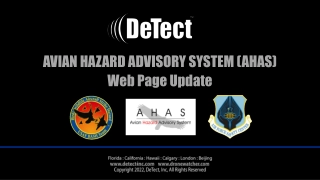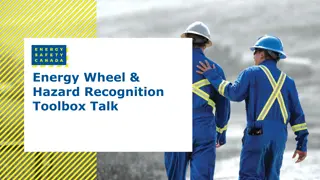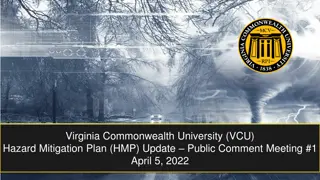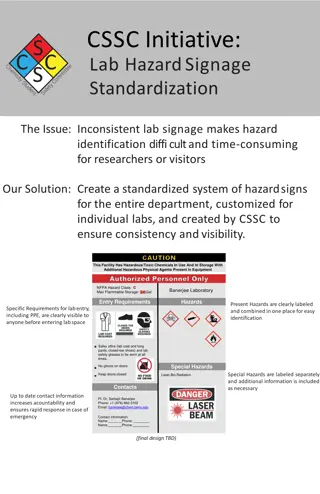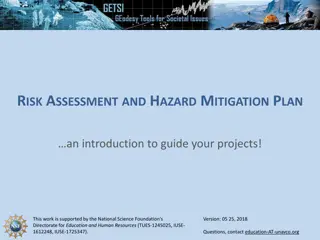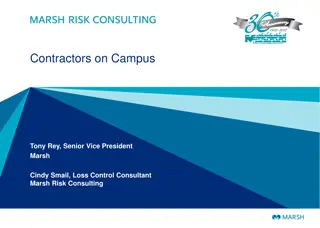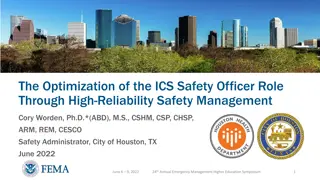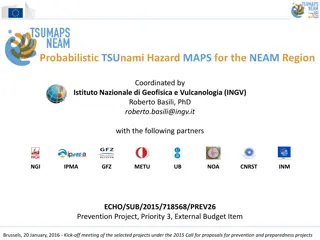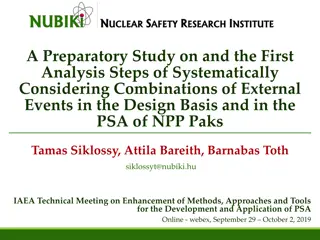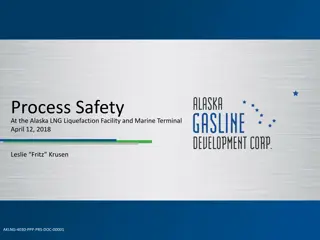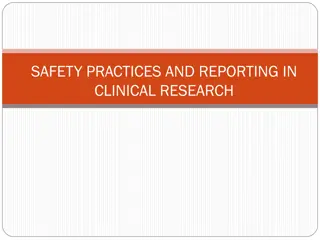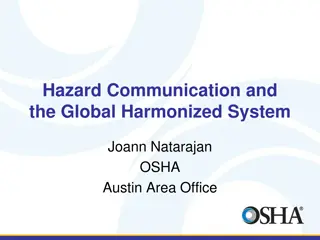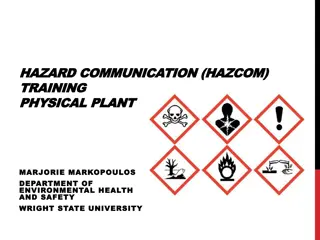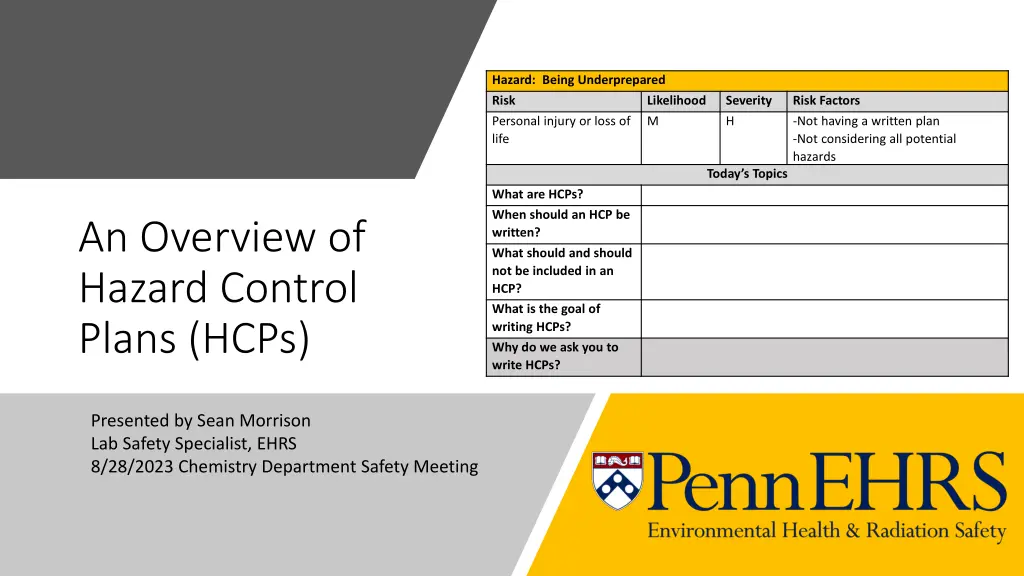
Lab Safety: Creating Effective Hazard Control Plans
Learn about Hazard Control Plans (HCPs) and their importance in preventing personal injury and loss of life in laboratory settings. Discover when and how to write an HCP, what to include, and what to avoid. Explore essential sections such as general information, hazards, controls, and emergency procedures to ensure the safety of lab personnel. Presented by Sean Morrison, Lab Safety Specialist, EHRS.
Download Presentation

Please find below an Image/Link to download the presentation.
The content on the website is provided AS IS for your information and personal use only. It may not be sold, licensed, or shared on other websites without obtaining consent from the author. If you encounter any issues during the download, it is possible that the publisher has removed the file from their server.
You are allowed to download the files provided on this website for personal or commercial use, subject to the condition that they are used lawfully. All files are the property of their respective owners.
The content on the website is provided AS IS for your information and personal use only. It may not be sold, licensed, or shared on other websites without obtaining consent from the author.
E N D
Presentation Transcript
Hazard: Being Underprepared Risk Personal injury or loss of life Likelihood M Severity H Risk Factors -Not having a written plan -Not considering all potential hazards Today s Topics What are HCPs? When should an HCP be written? What should and should not be included in an HCP? What is the goal of writing HCPs? Why do we ask you to write HCPs? An Overview of Hazard Control Plans (HCPs) Presented by Sean Morrison Lab Safety Specialist, EHRS 8/28/2023 Chemistry Department Safety Meeting
What are Hazard Control Plans (HCPs)? Lab-specific Standard Operating Procedure (SOP) documents. We have a template! 4 sections in an HCP: General Information Hazard/Process description, Training requirements Tasks, Hazards, and Controls Engineering Controls vs. Administrative Controls vs. PPE Other Considerations Storage, transport, waste, emergency procedures Related documents/References
When should an HCP be written? According to Penn s Chemical Hygiene Plan (CHP), one should be written when working with: Hazardous Compressed Gases Pyrophoric Materials Explosive Materials Power Supplies > 5 mA High-Pressure Work For any task that requires safety controls beyond those specified in a Penn SOP
2. Measuring out liquid reagent. 1. Setting up a dry ice or liquid nitrogen (LN2) cooling bath What should be included in an HCP? 3. Dispensing liquid reagent. You should discuss the individual steps your lab takes to perform a hazardous process. 4. Disposing of excess liquid reagent.
What should not You should notonly just copy/paste information from SDSs and/or Penn's CHP. It is fine to pull information from these, other HCPs, and other resources, but this cannot be your entire HCP! Please talk about the process in your lab. not be included in an HCP?
Hazard: Explosive Reagent What should be included in an HCP? Risk Likelihood Severity Risk Factors Unexpected reaction explosion M H Sealed vessels, incompatible chemicals reacting. Heating potentially explosive mixtures Controls Administrative [work practices] -All chemical compatibility should be thoroughly examined. -If working with sodium azide, avoid using metal tools, as sensitive metal- azides could form. Use plastic, glass, or ceramic tools instead. -Never run a potentially explosive reaction in a sealed vessel. -Do not heat reactions using explosive compounds. -If possible, avoid running reactions on days with ambient conditions that promote strong static discharge. Generally, this is when the air is very dry. -Alert other researchers in the lab that you will be working with explosives. -Do not handle explosive chemicals when working alone. -Post a sign on the fume hood when a process involving potentially explosive compounds is unoccupied. A template is available for download: Unattended Operations Sign Template You should briefly describe what the hazards are. ( General Information section) You should go into detail about how not to invoke a hazard-specific incident. ( Tasks, Hazards, and Controls section) e.g. How does my lab work with explosive chemicals and avoid a detonation? Engineering -Operate within a fume hood to contain an explosion or a glove box if your PI determines this is required. Keep fume hood sash closed as much as feasible. -Perform reactions behind a blast shield to contain an explosion. Personal Protective Equipment -Safety glasses, 100% cotton lab coat, solvent-appropriate gloves Other mitigating factors (inherent risk reduction) Recommendations for additional controls [EHRS USE ONLY]
What should not You should not focus on general advice about a hazard. Be specific to your lab! e.g. What is an explosive chemical? What does the Penn CHP say about explosives? not be included in an HCP?
What should be included in an HCP? You should organize your HCPs by classes of reactants (e.g. Hazardous Gases) or by application of reactants (e.g. Operating the AAS). Include notes about specific chemicals as necessary.
What should not You should not discuss chemicals reactant by reactant (or reaction by reaction). not be included in an HCP? 1. Introducing azides into organic molecules using sodium azide 2. Introducing azides to small molecules using 3-azido-1-propanamine 3. Introducing azides to natural or synthetic polymers using activated esters (e.g., azidoacetic acid-N-hydroxysuccinimide (NHS) ester) 4. Introduction of azides to proteins by aqueous diazo transfer using imidazole-1-sulfonyl azide tetrafluoroborate Hazard: Hydrogen Gas Hazard: Carbon Monoxide Gas Hazard: Oxygen Gas Hazard: Ammonia Gas Hazard: Flammable and Toxic Gases (Vinyl Bromide, 3,3,3-trifluoro-1-propene) Hazard: 1,1,1,2-Tetrafluoroethane Hazard: Flammable and asphyxiating gases (1-Butyne, 2-Butene, 2-methylpropene) Hazard: Toxic and corrosive Gases (Hexafluoroacetone, Methylamine, Trifluoroacetyl chloride)
What is the goal of writing an HCP? To have a standardized set of instructions/guidelines to a common, high-hazard process in writing that researchers will actually read and absorb information from. To prepare newcomers for verbal/hands-on training. To catch gaps in verbal/hands-on training and in practical knowledge. To Identify and fix flaws present in experimental design before performing the experiment. To prepare for an emergency, and to provide clear emergency information if ever unsure what to do.
What is the submission process for HCPs? A lab safety officer may request that your lab write an HCP or update an existing one. You might also self-inspect and find that your lab needs one. An HCP template is provided to help you start writing. You can request to see a completed HCP from another lab as well. Submit your completed HCP to ehrslaba@ehrs.upenn.edu for review. Receive feedback and suggestions from EHRS until we agree on a final revision. EHRS will upload your HCP to your BioRAFT profile.

